Your Cart is Empty
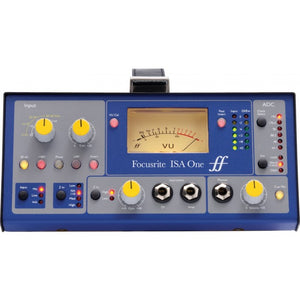
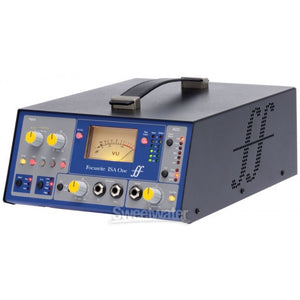
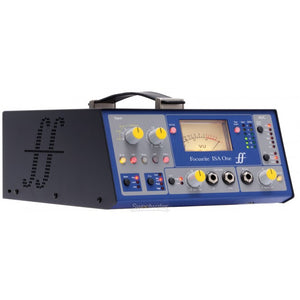
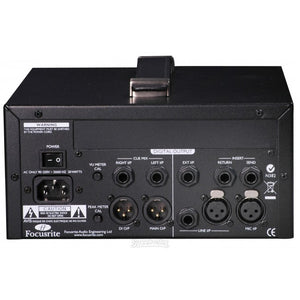
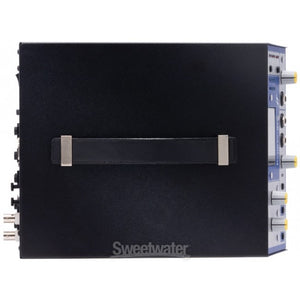
Product Information:
The ISA One microphone preamplifier delivers Focusrite's prestigious ISA transformer-based preamp in a rugged and portable chassis, at a groundbreaking price.
ISA One features the classic vintage microphone preamplifier topology from the original ISA110 module, which formed the cornerstone of each channel of Focusrite's legendary Forté console.
The preamp is complemented by a line input and an independent D.I. channel, complete with dedicated gain control, active or passive impedance switch, a TRS Jack output for routing to an amp and an independent XLR output on the rear. This flexible independent D.I. makes the ISA One ideal both for engineers wishing to blend a D.I.’d guitar signal with a mic’d guitar cabinet, and for demanding performers who require a single classic solution for both guitar and vocals.
Specifications:
We always quote 'real world' performance figures (measured to the AES17 standard). Some companies choose to quote chipset performance, which is misleading, and here's why.
Mic Input Response
Gain range = 0dB to 60dB in 10dB steps + 20 dB of variable gain
Input Impedance, variable as follows:
(Switched Impedance setting Equivalent Input Impedance at 1kHz)
Low = 600 Ohms
ISA110 = 1400 Ohms
Med = 2400 Ohms
High = 6800 Ohms
EIN (equivalent input noise) = -126dB measured at 60dB of gain with 150 Ohm terminating impedance and 22Hz/22kHz band-pass filter
Noise at main output with gain at unity (0dB) = -97dBu measured with a 22Hz/22kHz band-pass filter
Signal to noise ratio relative to max headroom (9dBu) = 106dB
THD at medium gain (30dB) = 0.0009% measured with a 1kHz -20dBu input signal and with a 22Hz/22kHz band-pass filter
Frequency response at minimum gain (0dB) = -0.5dB down at 10Hz and -3dB down at 125kHz
Frequency response at maximum gain (60dB) = -3dB down at 16Hz and -3dB down 118kHz
CMRR=98dB (Channel 1, 1kHz, maximum gain with +24 dBu input)
Crosstalk Channel to Channel: with 10dB@1kHz input to chA, chB output =104dBrA. With 10dB@10kHz input to chA, chB output = 84dBrA
Line Input Response
Gain range = -20dB to +10dB in 10dB steps + 20 dB of variable gain
Input Impedance = 10k? from 10Hz to 200kHz
Noise at main output with gain at unity (0dB) = -96dBu measured with a 22Hz/22kHz band-pass filter
Signal to noise ratio relative to max headroom (24dBu)=120dB
Signal to noise ratio relative to 0dBFS (+22dBu) = 118dB
THD at unity gain (0dB) = 0.001% measured with a 0dBu input signal and with a 22Hz/22kHz band-pass filter
Frequency Response at unity gain (0dB) = -0.3dB down at 10Hz and -3dB down at 200kHz
Instrument Input Response
Gain range = 10dB to 40dB continuously variable
Input Impedance:
High = greater than1M
Low =greater than 300k
Noise at minimum gain (+10dB) = -92dBu measured with a 22Hz/22kHz band-pass filter
Noise at maximum gain (+40dB) = -62dBu measured with a 22Hz/22kHz band-pass filter
THD at minimum gain (+10dB) = 0.001% measured with a 10dBu input signal and with a 22Hz/22kHz band-pass filter
Frequency Response at 10dB gain with -10dB input = 10Hz-100kHz +/- 0.6dB
Frequency Response at 40dB gain with -40dB input = -2.5dB down at 10Hz and 0dB at 100kHz
High Pass Filter
Roll off = 18dB per octave 3 pole filter
Fixed Frequency 75Hz measured at the 3dB down point
Meters
Moving coil (MC) meter is factory calibrated to 0VU = +4dBu with 1kHz sinewave. With the VU Cal button pressed the meter can be adjusted on the rear panel to allow 0VU to equal +10dBu to +26dBu with the centre detent being equal to +22dBu.
Peak LED meters calibrated in the detent position for 0dBFS = +22dBu, calibration is adjustable on the rear panel to allow 0dBFS to equal +10dBu to +26dBu
Routing for MC and Peak1 meter is after the HPF, pre insert send or switched post insert return. Peak2 is always pre ADC channel 2, which can be fed by external input or Instrument input.
LED levels are as follows when peak calibration is set to center detent on the rear panel. (This is when using the internal ADC).
0 = +22dBu
-2 = +20dBu
-6 = +16dBu
-12 = +10dBu
-18 = +4dBu
-42 = -20dBu
FRONT AND REAR CONNECTIVITY
Analogue Channel Inputs:
Mic input: XLR x 1
Line input: XLR x 1 and TRS x1
Instrument input TRS Jack: XLR x 1
External ADC input: TRS Jack x 1
Return: TRS Jack x 1
Analogue Channel Outputs:
Send: TRS Jack x 1
Balanced line output: XLR x 1
DI output: XLR x 1
DI through: TS Jack x 1
Analogue Channel Additional I/O:
Cue mix left input: TRS Jack x 1
Cue mix right input: TRS Jack x 1
Headphones output: ¼” TRS Jack x 1
Weight
3.9kg
8.6Ibs
Dimensions
220mm (W) x 104mm (H) x 254 - 290mm (D - top to bottom)
8.66" (W) x 4.1" (H) x 10" - 11.4" (D - top to bottom)
Warranty
3 Years WarrantyShipping & Delivery
All orders over $100 will be automatically eligible for FREE Shipping Australia Wide, if you order is under $100 there will be a flat rate of $10.
Belfield Music is well known for its top online customer service. We treat all online customers with the same excellent service we give to our in store customer. We will ensure that you receive all the support you need while your goods are in transit and ensure the goods arrive promptly. All of our shipments have tracking numbers available and we cover every single unit by our own shipping insurance.
Online orders are normally processed within 1-3 business days. Once processed, your order should take between 1-8 business days to arrive depending on your location. Please note that your order may take up to 10 business days to arrive from the day you place your order.
If it transpires that the product is out of stock due to a stock discrepancy and/or there will be a delay in shipment, we will contact you within 2 business days of placing your order and give you the option of waiting or cancelling your order. The products we advertise online should show if they are in stock or not. We do our best to keep the website stock count up to date, but there may be an occasional error.
If you wish to utilize an Express Delivery Service to receive your item, please contact us for a shipping quote before you place your order at admin@belfieldmusic.com.au or by using the Chat icon on the bottom right of the page.
Deliver is made during the hours from 8:00am till 5:30pm Monday to Friday. As such, please ensure you nominate an address which is capable of receiving goods during 8am and 5.30pm. Given the restrictions on PO Box deliveries we cannot deliver larger sized items to a PO Box.
If for any reason our selected carriers don't service your area we will contact you before processing your order if this applys to you.
Returns Policy
If you wish to return an item which is not damaged or faulty in any way and you have simply changed your mind or made the wrong decision, you must let us know within 7 days of receiving the item. We will not agree to refund an item because you simply changed your mind or made the wrong decision if we have not been advised of your intention within 7 days of receiving your item. Once we have provided a return authority, it is the buyer’s responsibility to return the item, at their own costs within 30 days from original purchase. If the item is returned with any damage or alteration to its original packaging, we will refund the item subject to applying a minimum 15% restocking fee. We will not refund the costs of the initial shipping charges.
It is in Belfield Music best interests to keep our customers happy with their purchases. If you are not happy with your purchase, please talk to us first. We will always attempt to resolve any problems you may have as best we can. To contact us please email us at admin@belfieldmusic.com.au or by using the Chat icon on the bottom right of the page.












